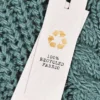You can contact us 24/7 447771208062
Young, urban fashion consumers actively seek out sustainable options, but most shoppers remain neutral to the idea. In fact, many find it challenging to figure out what actually constitutes “sustainability,” with a long, complex list of potential factors to consider.
This could change, however, as millennials and Gen Zers reach both the age and income levels to apply their eco-conscious values and beliefs to their wardrobes. In turn, this demand could spur clearer messaging and more sustainable practices from brands.
These findings are from a recent McKinsey survey in the United Kingdom that looked at consumer sentiment about sustainability in clothing, footwear, and accessories.1 Despite increased awareness about the importance of sustainability, the fashion industry’s environmental footprint remains significant. Companies create far more products than they can sell, and more than half of all global fiber produced is polyester, a material that requires a great deal of energy for extraction and processing and that lingers in the environment for a long time.2 In total, the fashion industry emits about the same quantity of greenhouse gases (GHGs) per year as the economies of France, Germany, and the United Kingdom combined.
As environmental, social, and governance (ESG) transparency continues to grow in importance, fashion companies will likely feel pressure to do more. For example, starting next year, the UK government will require listed companies to publish net-zero transition plans and set company targets to mitigate their climate risk. Certain public companies will also be required to disclose climate-related financial information that follows standards set by the Task Force on Climate-Related Financial Disclosures (TCFD).
Mockup with organic cotton tote bag and jeans.
Sustainability seekers
One-quarter of respondents to our survey indicated that they are concerned about sustainability-related issues (Exhibit 1). These consumers go out of their way to buy secondhand items and to look for clothing made with environmentally friendly material, such as recycled polyester. Our research shows that this group, which is willing to pay 15 percent more for sustainable options, is more likely to consist of urban millennial women with moderate to high incomes (Exhibit 2). The factors that these sustainability seekers care most about are the lowering of GHG emissions, the preservation of natural habitats for animals, practices that don’t harm animals, and the use of renewable energy (Exhibit 3).
Exhibit 1

We strive to provide individuals with disabilities equal access to our website. If you would like information about this content we will be happy to work with you. Please email us at: [email protected]
In contrast, about half of our survey respondents were ambivalent about sustainability, while another one-quarter emerged as a strong counterbalancing contingent. These consumers said that they were actively not interested in seeking out sustainable fashion choices.
Exhibit 2

We strive to provide individuals with disabilities equal access to our website. If you would like information about this content we will be happy to work with you. Please email us at: [email protected]
As environmental, social, and governance (ESG) transparency continues to grow in importance, fashion companies will likely feel pressure to do more.
Exhibit 3

We strive to provide individuals with disabilities equal access to our website. If you would like information about this content we will be happy to work with you. Please email us at: [email protected]
One factor that is likely holding these consumers back is a general confusion about the term “sustainability.” Customers rely most on brand websites and product tags when evaluating fashion brands and products (Exhibit 4). But these sources often contain a bewildering array of sustainability features, credentials, and claims, impairing a consumer’s ability to make easy, educated choices. No shared understanding exists among consumers (or brands) about what exactly “sustainability” means, which features matter most, or where to find information about a particular brand’s sustainability commitment. It can be even harder to find independent sources that help distinguish between authentic sustainability claims and greenwashing.
Exhibit 4

Fashion brands have a significant opportunity to deliver clear, straightforward information on their practices (both at and before the point of sale), as well as frictionless postpurchase options that consumers can use to mitigate the impact of their fashion choices.





